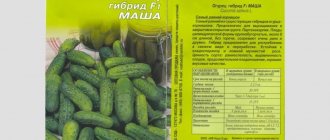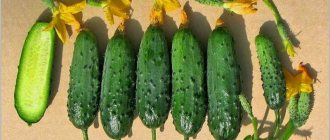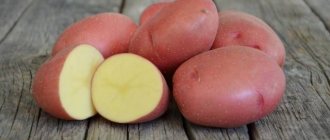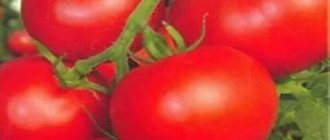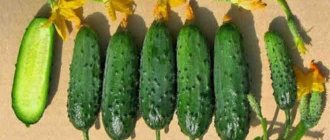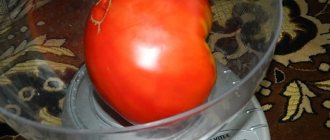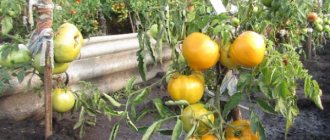Characteristics and description of the variety
The Tolstushka agro variety is intended for regions with harsh climates. It is distinguished by its endurance and adaptability to adverse conditions.
Reference. Agro has been a leader in the seed sales market for many years.
Distinctive features
The bush is determinate, compact, no more than 80 cm high. The stem is strong, the foliage is medium, the leaves are small, dark green. The first cluster is formed after the 9th leaf; each cluster bears 8 fruits. The inflorescences are simple.
A mid-early variety, it takes 115-120 days from planting to full ripening.
Immune to major diseases of the nightshade family. Recommended for cultivation in open ground and in greenhouses.
Productivity is high: up to 7 kg of fruits are harvested from 1 bush, provided that 3-4 seedlings are planted per 1 sq. m. m.
Despite its short growth, the plant requires garter, otherwise the branches will not withstand the weight of ripe fruits. Culture needs stepsoning. For the best quantitative indicator, the bush is formed into 2 stems.
Fruit characteristics
The fruits are large, with an average weight of 200-250 g, flat-round in shape, red in color. The taste is sweet, with barely noticeable sourness, the flesh is juicy, the skin is dense. There are 4 seed chambers, few seeds.
Universal use in cooking: the fruits are well suited for fresh salads and preparations for the winter. They do not lose their taste when processed into tomato products: juices, ketchups, lecho. Smaller tomatoes are used for whole-fruit canning. Tomatoes go well with other vegetables.
They are subject to long-term storage and retain their appearance well during long-term transportation.
The photo shows Tolstushka tomatoes.
Eating tomatoes
The sweet taste and pleasant aroma of the pulp make it possible to use tomatoes in different ways.
- They work well in salads.
- The good yield of tomatoes and the ability to be preserved for a long time allow for long-term harvesting of fresh fruits.
- The juices taste delicious, with a large admixture of pulp.
- Ketchup, adjika and sauces can also be prepared for the winter.
- For preservation in its entirety, fruits of the second wave of ripening are suitable - they are smaller than the first.
Colorful and tasty salads will appeal to everyone, even gourmets.
Tomato slices and herbs can also be used to decorate other dishes such as pizzas, kebabs or potato casseroles. You can add bell peppers, spices and herbs to adjikas, ketchups, sauces and other semi-finished products.
How to grow seedlings
Sowing of seeds begins 2 months before planting seedlings in the ground. This crop belongs to a hybrid culture, so seeds for planting are purchased each time in specialized stores.
Reference. Seeds of hybrid crops do not retain their parental properties, so independent harvesting for subsequent plantings does not make sense.
Seed preparation
First, the seed is checked for external defects. All seeds should be smooth, light in color and without visible damage. To determine whether the seeds are empty or not, they are dipped in a saline solution. To do this, dissolve 1 teaspoon of salt in 1 glass of water and place it in the grain solution for 10 minutes. Those seeds that float to the surface are not suitable for sowing.
The remaining ones are disinfected in a weak solution of potassium permanganate for 20 minutes. Then they are washed with running water, wrapped in gauze, slightly moistened and left in a dark and warm place for 3 days, wetting the gauze with warm water as it dries. As soon as the grains sprout, they are sown in the ground.
Reference. To improve germination, seeds are soaked in a growth stimulator for 8-10 hours.
Container and soil
The soil is prepared from garden soil, peat and sawdust in a ratio of 7:1:0.5. For lightness, add a little washed river sand to the soil mixture. After thoroughly mixing all the components, the soil is fertilized with humus or mullein infusion. The resulting soil is laid out in planting containers, in which small holes are made in advance at the bottom so that excess moisture does not retain.
Plant in a common wooden box or individual containers, for example, plastic cups, paper honeycombs and peat pots.
Reference. Peat pots contain a complex of useful substances that nourish the sprouts before planting in the ground.
Sowing
Seeds are sown to a depth of 1.5-2 cm at a distance of 3 cm from each other. Then the soil is leveled from above and lightly moistened with a spray bottle. Planting containers are left in a warm and dark room at an air temperature of 22-24°C. Containers must be covered with film or glass to create a greenhouse effect.
Growing and care
When the first shoots appear, the containers are moved to a well-lit place. There should be at least 12 hours of daylight. In case of insufficient natural light, add phytolamps, which are installed at a distance of 30 cm from the seedlings.
Daytime temperature should not exceed 24°C, at night 18°C is sufficient. The room where the seedlings are located is regularly ventilated, but protected from drafts, which have a detrimental effect on young plants.
Planting containers are watered with warm, settled water as the top layer of soil dries out using a shallow watering can along the edge of the nursery. After watering, the soil is loosened superficially so as not to damage the young roots.
When 2 true leaves appear, the seedlings are picked and placed in separate containers.
Reference. When sowing seeds in peat pots, picking is not required.
3 weeks before transplanting into the ground, seedlings begin to harden in order to quickly adapt to street conditions. To do this, young bushes are taken outside for 30 minutes - 1 hour in the daytime. The temperature in the room at night, where the seedlings are brought, is lowered to 13°C. Gradually, the time spent on the street is increased to 14 hours.
Preparing seedlings
To obtain a high yield, Tolstushka tomato seeds are germinated indoors. The resulting seedlings are transferred to the site in late spring. The seedling method is reliable and effective, but in the southern regions it is permissible to plant seeds directly into the ground.
Planting seeds
Planting work begins with soil preparation. It is obtained by combining peat, turf soil and sawdust in a ratio of 7:1:1.5. The soil for tomatoes is fertilized with humus or rotted manure.
An alternative option is to purchase ready-made soil intended for growing tomatoes. It is convenient to plant seeds in peat pots containing a complex of useful substances.
Advice! Seeds of the Tolstushka tomato variety are placed in salted water. Any grains on the surface are removed.
The remaining seeds are wrapped in several layers of gauze and placed in a light pink solution of potassium permanganate. After half an hour, the gauze along with the seeds is washed with warm water, then left in a plate for 3 days. The fabric is constantly moistened with water.
The soil is moistened and poured into containers. Prepared seeds of the Tolstushka variety are planted at intervals of 2 cm and covered with a layer of chernozem 1 cm thick. The containers are covered with glass or polyethylene, and then kept warm without access to light.
Conditions for seedlings
When tomato sprouts appear, the containers are moved to a window or other illuminated place. For half a day, seedlings should be illuminated by the sun or phytolamps. Lighting devices are placed at a height of 30 cm from the sprouts and turned on during short daylight hours.
Thick tomato seedlings are provided with other conditions:
- temperature during the day is 21-25°C, at night 16-18°C;
- watering with warm water;
- ventilation of the room.
To water the Tolstushka variety, use settled water. It is more convenient to spray plants from a spray bottle. It is enough to add moisture 1-2 times a week when the soil begins to dry out.
When the seedlings have 2 leaves, they are transplanted into larger containers. If tomato seeds were planted in peat soils, then replanting is not required. Before picking, water the tomatoes and then carefully transfer them to a new container along with a lump of earth. Use the same soil as when planting seed.
3 weeks before transferring to the site, the tomatoes are hardened. In the room with seedlings, open the window for several hours, but protect the tomatoes from drafts. Then the containers are moved to the glazed balcony. Before planting, tomatoes should be left in the fresh air for 24 hours.
How to grow tomatoes
After 2 months, the seedlings are ready for transplanting. By this time, young plants reach a height of 25 cm, they have a fully developed root system and at least 6 true leaves.
Landing
A place for beds with tomatoes is chosen in the fall, taking into account what crops grew on the ground previously. Tomatoes are planted where legumes, melons, carrots or beets grew before them. Following the rules of crop rotation leads to maximum fruiting rates. The soil is fertilized with wood ash and humus.
In spring, the ground is loosened, removing weeds with roots, and holes are made 15 cm deep.
Planting pattern: 40 cm – distance between seedlings, 50 cm – between rows. For 1 sq. m place 4-5 plants in a checkerboard pattern. This method of planting provides maximum lighting and ventilation for young bushes.
The seedlings are transferred into the holes along with a lump of earth, sprinkled with soil and compacted. Then water abundantly and do not disturb the bushes for 2 weeks. During this time, tomatoes adapt to new conditions.
Tomato care Fatty
Regular watering is established as seedlings take root in open beds. Water only with warm, settled water, strictly at the root, without getting on the leaves. The water is pre-settled and heated in the sun in barrels. Before flowering begins, apply 5 liters of water under each tomato bush.
When forming buds, the amount of moisture is reduced to 3 liters, since excess leads to cracking of the fruit. Water at least 2 times a week. On hot and dry days, watering is increased up to 3-4 times as the soil dries out.
After each watering, the soil is loosened and hilled up. This agricultural technique not only saturates the soil with oxygen, but also becomes a preventative measure in the fight against late blight and pests.
The first feeding is carried out 2 weeks after transplanting the seedlings. Bird droppings (1:15) are well suited as fertilizer at this stage of development. But since the fertilizer contains nitrogen, it is not used in the future.
The second feeding is applied when the ovaries are forming. Feed with potassium-phosphorus fertilizer, for example, superphosphate and potassium sulfate (40 g of each fertilizer is dissolved in 10 liters of water). These microelements are also fed during the fruiting period.
Important! The culture responds well to the addition of organic matter. Universal fertilizer – wood ash. It is added to the water 2 days before watering.
Features of cultivation and possible difficulties
Thanks to the small number of shoots, the bushes do not require regular pinching, which significantly simplifies care. But for a better quantitative indicator, plants are formed into 2 stems.
The crop cannot be done without a garter, otherwise the branches will not support the weight of ripe fruits. Tie as necessary to wooden or metal supports. This will not only protect the plants from damage, but will also simplify harvesting.
Diseases and pests
The culture has proven itself to be highly resistant to the main diseases of the Solanaceae family.
Preventive treatment of plants includes spraying with Bravo preparations or copper sulfate. “Bravo” is a contact fungicide and provides good protection against fungal diseases, such as late blight. Copper sulfate also has the same effect.
Decoctions of onion peels and garlic (100 g per 1 liter, infuse for 1 day) save you from viruses and pests. The finished infusion is diluted with water 1:10 and sprayed on the plants. Many pests are repelled by strong odors and decoctions of strong-smelling herbs. Also, such herbs are planted next to tomatoes, and mustard bushes can even repel the Colorado potato beetle.
Variety care
Thick tomatoes require constant care. Plantings are watered and various types of fertilizers are applied.
According to its characteristics and description, the Tolstushka tomato variety is classified as undersized. The bush does not require shaping, which simplifies the care of the variety. Tomatoes are tied to a support. To prevent the fruit clusters from falling to the ground, a net is stretched between the tomatoes.
Watering plants
Tomatoes Tolstushka are watered regularly. At different stages of development, tomatoes require a certain amount of moisture. Before use, water is poured into barrels, where it must be warmed and settled.
After planting and before flowering begins, apply 5 liters of water weekly under the roots of the tomatoes. In young plants, the root system is not yet sufficiently developed to extract moisture from the deep layers of the soil.
Advice! A lack of moisture is indicated by curling and wilting of the tops.
When the buds and ovaries begin to form, water the Tolstushka tomatoes more often. Every 3-4 days, 3 liters of water are added under the bushes. When fruiting, you need to reduce watering to 3 liters of water weekly. Excess moisture causes cracking of tomato fruits.
Fertilizer application
Fertilizing promotes the development and fruiting of Tolstushka tomatoes. After planting, the tomatoes are fertilized with a solution of bird droppings diluted with water 1:15. The fertilizer contains nitrogen, so in the future it is better to choose fertilizers with other microelements.
Advice! During the formation of ovaries and fruiting, tomatoes are fed with potassium-phosphorus fertilizer.
You can get a product for processing Tolstushka tomatoes by dissolving superphosphate and potassium sulfate in 10 liters of water. Each substance is measured in 40 g.
Treating tomatoes leaf by leaf helps replace root feeding. Then take 10 g of mineral fertilizer per large bucket of water.
Tomatoes Tolstushka react positively to organic fertilizers. Wood ash is a universal fertilizer. It is added to the water 2 days before watering. The ash can be embedded in the soil to a depth of 5-8 cm, after which the plantings can be watered.
Protection from diseases
The tomato variety Tolstushka has average resistance to pathogens. Plants rarely suffer from fusarium and verticellosis. If the rules of agricultural technology are violated, the spread of blossom end rot of tomatoes may occur. If dark spots appear on the leaves and stems, the affected parts of the plants must be eliminated. Plantings are treated with products that contain copper.
To protect against diseases, watering standards are observed, the greenhouse or greenhouse is regularly ventilated, and excess tops are cut off. Every 2-3 weeks, preventive treatments are carried out with Fitosporin or other biological products.
The nuances of growing in open ground and in a greenhouse
The variety is recommended for cultivation in protected and unprotected soil. The Fat Tomato takes root well in open beds in warm areas and in regions with a temperate climate. Where summers are short and cold, the crop is grown in greenhouses or under covering material.
It is recommended to regularly ventilate protected structures to avoid the spread of infections and pests. Greenhouse conditions are the most favorable for a pathogenic environment, which is destroyed by a regular influx of fresh air.
Experienced gardeners advise removing the lower leaves, otherwise they can cause late blight. When planting, it is necessary to avoid crowding of plants. Frequent planting not only reduces yields, but also leads to the spread of pests.
Pros and cons of the variety
Tomato Tolstushka is unpretentious in care and does not require pinching or additional shaping of the bushes.
You can get a good harvest even in regions with an unfavorable climate if you grow the crop in a greenhouse
pros
- compact bush size;
- high productivity;
- good taste of fresh fruits;
- resistance to pests and diseases.
Minuses
- greenhouse cultivation;
- massive fruits not suitable for whole fruit canning.
Important! The yield and taste of tomatoes of the Tolstushka variety do not depend on solar activity.
Even the shortcomings of the Tolstushka variety can be called its features, which do not spoil the overall impression of the culture.
Harvesting and application
Ripening begins 90-95 days after the first shoots, but the period of the most abundant yield occurs on days 110-115 and lasts for another 2 weeks. Subsequent fruits weigh less than the first, so they can be used for whole-fruit canning.
Maturation in the hand is almost simultaneous, which simplifies collection. It is not necessary for all tomatoes to ripen completely; Tomatoes are also harvested when they are pink; they are quite capable of gaining color on their own at room temperature.
Harvesting vegetables earlier allows plants to lay down new fruiting clusters without becoming depleted.
The use of ripe vegetables is universal: they are consumed fresh, for pickling, marinades, canning, and processed into tomato products. Tomatoes are good in summer salads, hot and vegetable dishes, baked with meat, and perfectly complement the taste of other vegetables. They make excellent juices, pastes, ketchups, adjika, and lecho. Vegetables do not lose their taste in pickles and marinades.
Thanks to their thick skin, tomatoes can be stored for a long time and can withstand long-term transportation without losing their appearance or taste.
Description
The tomato variety Tolstushka is a determinant variety; the bush usually reaches 70-90 cm. However, there are also tall hybrids of the same name, reaching 150-250 cm.
When purchasing seeds, carefully study the description and characteristics of the variety on the packaging.
The variety belongs to the mid-early variety and begins to bear fruit 110-115 days after sowing.
Fruit
Tomato Fatty is round, “plump”, slightly flattened. Has weak or medium ribbing. Color – bright red. Weight – from 200 to 350 g. The pulp is sweet, the peel is dense.
The fruits are great for salads, snacks, fresh cuts and preparing main courses. Large specimens from the first harvest can be preserved in pieces, and subsequent, smaller specimens can be preserved whole.
Due to their tender pulp, they are often used to make ketchup, sauces, juice and pastes.
Productivity
This tomato is distinguished by consistently high yield. With proper care, 6-7 kg of tomatoes can be harvested from one bush. The fruits on one cluster ripen at the same time - they can be collected immediately. On average, the crop is harvested every 4-6 days.
Advantages and disadvantages of the variety
Tomato Fatty has many positive qualities:
- ease of care;
- immunity to diseases;
- ability to take root in any climatic conditions;
- does not require mandatory stepsoning;
- high fruiting rate;
- excellent taste of fruits;
- amicable maturation;
- universal use;
- long-term storage;
- long transportations.
The disadvantages of the culture include the obligatory garter.
Features of cultivation
Seeds for seedlings are sown in early March. Tomato plump requires neutral soil with good drainage. It is prepared in advance by mixing garden soil with sand, humus and peat in equal parts.
The nutrient mixture will allow you to grow strong seedlings without the use of fertilizers
A drainage layer is poured onto the bottom of the containers for seedlings, and the prepared soil mixture is covered on top. The containers are first doused with boiling water, and the soil is fried in the oven for 2 hours to disinfect.
2 days before planting the seeds, they are moistened in warm water, laid out on damp gauze, and allowed to hatch.
Make shallow furrows on the surface of the nutrient soil mixture using a ruler.
The seeds are laid out in a rut at the same distance from each other (1-1.5 cm), covered with light fluffy soil, and watered. The containers are covered with film and placed in a warm, well-lit place. The air temperature during the day should not fall below + 28 ᵒС, and in the evening + 18 ᵒС. The soil is moistened as the top layer dries.
As soon as the first shoots hatch, the film is removed, daylight hours are increased to 12 hours, including artificial lighting.
After two leaves appear on the seedlings, each plant is planted in larger pots
The seedlings do not need fertilizing; they receive all the necessary substances from the soil mixture.
2 weeks before the expected date of planting seedlings in open ground or a greenhouse, they are hardened off. The seedlings are taken out to the balcony during the day for half an hour or an hour, gradually extending the time of the air baths.
Seedlings are planted in a greenhouse at the end of April, and in open ground - in the first half of May, in the southern regions - as soon as the soil warms up well.
The area is carefully dug up, 20 g of urea and 10 g of potassium sulfate are added per 1 square meter. m. Planting holes are dug at a distance of 0.4 m, and an interval of at least 0.5 m is maintained between rows.
Supports are immediately installed near each hole
After planting, the tomato bushes are thoroughly watered, and the next day the soil is loosened. Watering is carried out as the top layer dries. It is important to ventilate in greenhouses. Once every 2 weeks, fertilize with mullein solution, pouring it directly under the root. To prevent the fruits from rotting, weeds are removed and the soil is mulched.
As soon as the ovaries begin to form, the tomato bushes are tied up. The Tolstushka tomato does not need pinching or bush shaping.
Farmer reviews
Feedback from farmers is unanimous: everyone claims that the crop can take root and produce a good harvest in areas with harsh climatic conditions. This is an important factor for residents of the northern regions. Opinions of those who planted this variety:
Diana, Leningrad region: “I planted the fat plant in a film greenhouse; when it gets cold, you can close it and not worry about the safety of the crop. The fruits were large, moderately dense, with aromatic and juicy pulp. The plant is low and takes up little space in the greenhouse. Maintenance is minimal: just watering and fertilizing. There’s no need to step-son.”
Alexander, Krasnoyarsk: “I am constantly looking for productive large-fruited tomatoes. I grow different species for sale. I really liked the Tolstushka tomatoes from the description and photographs, so I allocated a separate bed for them. The bushes are not tall, but the fruits are large and heavy. I collect 5-6 kg from a bush. I breed, of course, only in the greenhouse.”
Characteristics of the tomato Fatty
This is a mid-early, determinate variety. It is recommended to grow it in greenhouses, greenhouses, and film-type shelters. In open ground, the Tolstushka variety is grown in the south of Russia.
The bush is not tall, the length of the stem does not exceed 80 cm, but it needs a garter, since full-sized fruits can damage the plant during the ripening period.
This is a natural variety, not a hybrid, its seeds are suitable for collection and further germination.
Seedlings of the Tolstushka variety are recommended to be rooted in areas where zucchini, parsley, and cauliflower were previously grown.
The fruits of the variety retain good presentation for a long time and are suitable for transportation. Thanks to the dense peel, they do not crack. If the fruits are collected at the stage of technical maturity, they can be stored for a long time in a cool room, and spontaneous ripening occurs.
Since 2011, the Tolstushka tomato has been included in the State Register of the Russian Federation as a variety recommended for cultivation in spring film greenhouses.
Tomato yield Fatty and fruiting
The ripening of Tolstushka tomatoes begins in the second half of July. Farmers harvest up to 7 kg of tomatoes from one bush. The weight of the first fruits reaches 250 g, the second harvest is more modest: the weight of each tomato does not exceed 190 g.
It is recommended to grow the Tolstushka tomato under film and only in the southern regions - in open ground
Regular watering and fertilizing have a good effect on crop productivity. In warm climates with stable temperature conditions, the Tolstushka variety bears fruit best.
Fruit ripening is uniform, which greatly simplifies harvesting. It is recommended to remove tomatoes from the bush once a week. The fruits can be harvested at technical maturity; they turn red quickly, are stored well, retain a unique taste, and the plant has the ability to quickly form new ovaries without becoming depleted.
Area of application of fruits
Tomatoes of the Tolstushka variety have a universal purpose: they are suitable for processing and fresh consumption. The large size of the fruit does not allow it to be used for whole fruit canning. Tomato juice, paste, lecho, and various sauces are prepared from tomatoes. The taste of tomatoes of the Tolstushka variety is well revealed in summer salads with herbs.
Resistance to diseases and pests
The tomato is resistant to diseases, especially fusarium and verticillium, but can suffer from blossom end rot. Bushes must be regularly inspected and quickly responded to the appearance of the first signs of disease. Insects rarely attack the Tolstushka variety.
Application
Tolstoy tomatoes F1 are universal in use. A variety of salads, side dishes, and preserves are prepared from ripe tomatoes. These tomatoes are also suitable for pickling and pickling; they retain their shape and do not crack. These fruits make a very tasty juice, with virtually no need to add sugar. In addition, Tolstoy tomatoes are suitable for pickling in an unripe state.
Watch the video ! Tomato Tolstoy
Care
Tomato Black Crimea
Tomato Pyshka, as the people call Fatty, does not require a lot of attention and careful care, but some activities must be carried out. These include weeding between rows and gentle loosening of the soil (so as not to injure the roots). It is enough to water the tomatoes once a week, and fertilize them three times during the entire growing season. Both chemicals and organic matter are used as fertilizers. You can use bird droppings, mullein, or a mixture of herbs. The tomatoes are fed for the first time before fruit formation begins, and in subsequent times the interval between fertilizing should be at least 10-15 days.
Tomato Fatty ripens
Despite the fact that Tolstushka exhibits good resistance to diseases and pests, preventive measures will not be superfluous. For these purposes, the drugs Bravo or Aktara, as well as other similar products, are used. To avoid the appearance of fungal infections, plantings are treated with Bordeaux mixture. To prevent small pests and insects from bothering them, tomatoes are periodically sprayed with onion and garlic tincture.
Growing seedlings
Almost all varieties of tomatoes are grown by seedlings. Our Fatty is a hybrid, so it is necessary to purchase its seeds every year. Collected independently, they will not give, when grown, those characteristics and features that are inherent in this variety.
At least 60 days must pass before the finished seedlings need to be planted in a permanent place. This means that in March you need to prepare containers - nurseries, soil and seeds.
The description of the most fertile soil for nightshades says that the soil should consist of several components:
- garden soil 70%;
- peat 10%;
- rotted mullein 10%;
- sand 5%;
- sawdust 5%.
Drainage is poured into the container, then soil and seeds are placed on it, previously soaked in growth stimulants for 8 hours and washed. A layer of earth of about 1 cm is added on top, leveled and sprayed with water from a spray bottle.
The containers are covered with transparent film or glass and placed in a bright place. The temperature during the day should not exceed 25°C, and at night about 18°C. As the top layer of soil dries, the soil should be sprinkled with warm water.
Seedling care
Only with proper care will the plant please you with a harvest
Care comes down to the fact that you need to maintain the temperature regime. Lighting, if there is not enough natural light, must be turned on additionally. At the second leaf stage, the seedlings are planted and the containers are opened. Before planting in open ground, it is hardened off for 2 weeks, exposed to the sun for a short time.
Planting Tolstoushka tomatoes in the ground
When planting in greenhouses or open ground, mark the holes so that there are no more than 4 plants per 1 m². Supports are installed near the holes, and the holes are spilled with water. The seedlings are planted and, if necessary, tied up.
Characteristics of the variety
The Tolstushka variety belongs to the indeterminate species. Its characteristics are generally similar to all plants of this type.
- This is a tall hybrid; its height in closed ground can reach 2.5 - 3 m.
- The variety is considered early, due to the ripening of the fruits.
- It is grown in 2 stems, and the tomato yield will be greater.
- Green fruits collected at the coloring stage are capable of ripening.
- Tomato Thick is suitable for all types of consumption.
- The plant is resistant to viruses and diseases inherent in nightshade crops.
Not everyone has a huge greenhouse, so each gardener chooses his own method of growing and limiting the growth of tomatoes.
The best predecessors for tomatoes will be crops such as:
When grown, they do not deplete the soil. And legumes are able to accumulate nitrogen in the root area, which is necessary for the growth of all plants.
Planting seedlings in a permanent place
Young Tolstushka bushes, growing in peat cups or tablets, are planted with them. When using plastic containers to facilitate the process of removing the root ball, stop watering 1–2 days before planting. The substrate is well moistened just before placing it in the hole, then the lump will stick to the roots and will not crumble.
Deadlines
The seedlings are ready for planting when they reach a height of 25 cm, have 5–7 leaves , the first flower cluster and a well-developed root system.
Important! If the seedlings are kept in pots and allowed to bloom, they will stop growing and then in the beds, even with good care, will not recover and will not produce a full harvest.
In May-June, depending on the region, when the ground warms up to +15°C and the threat of frost has passed, the bushes are planted in open ground. When planting in a greenhouse, this period occurs 2-3 weeks earlier.
Choosing a location on the site
For a tomato bed, choose the warmest and sunniest place on the south side of the house or building. It is advisable to fence the plantings on the north side with tall plants, for example, sunflowers. Be sure to take into account what crop grew in this place last season. Suitable predecessors for tomatoes are zucchini, cucumbers, onions, parsley or carrots. You should not re-grow tomatoes in the same place after potatoes or other nightshades, as they are affected by common diseases and pests.
The soil for the garden begins to be prepared in the fall. The site is dug up, adding organic fertilizer - compost, manure or bird droppings. In the spring, additional loosening is carried out, weeds are removed, and before planting, 20–30 g of nitrogen and 10–15 g of potassium fertilizers are added per 1 m².
Planting scheme
It is advisable to plant in cloudy, windless weather. Tolstushka seedlings are planted according to a 50x40 cm pattern, with 7–8 plants per 1 m². If you place the bushes in a checkerboard pattern, they will receive more sunlight.
The holes are well shed with water and a handful of humus is added to each. Having established the root ball at the same level as before, cover it with soil, mixing it with humus and gently pressing it in a circle. Then water again abundantly and mulch the soil surface with peat.
Characteristics
Tomatoes "Lentyayka" are a prominent representative of Siberian selection. This tomato was obtained by Russian breeding scientists and the variety received state registration in 2010. Tomatoes of the “Lentyayka” variety tolerate frost well and are not harmed by temperature fluctuations. Therefore, tomato produces a good harvest both in the middle zone and in colder regions.
In the Voronezh, Astrakhan, Vologda regions, the Caucasus and the Krasnodar Territory, it is better to plant in open beds. In the Southern Urals and in more severe regions it is necessary to plant only under film covers.
You also need to take into account that this species needs good supports, without this there will be poor growth and productivity will fall.
“Lentyayka” tomatoes are great for prefabricated preserves and pickles. Most often consumed fresh, in vitamin salads. Can be used in dried form. The fruits produce wonderful, tasty tomato juice and thick, high-quality paste. Productivity is high; 5-6 kg can be harvested from one adult plant.
Under the right conditions and active feeding, it is possible to get up to 15 kg per 1 sq.m. This is a good result for such a short plant.
You can compare the yield of this variety with others in the table below:
| Variety name | Productivity |
| Lazy | up to 15 kg per square meter |
| Gulliver | 7 kg per bush |
| Lady Shady | 7.5 kg per square meter |
| Honey Heart | 8.5 kg per square meter |
| Fat Jack | 5-6 kg per bush |
| Doll | 8-9 kg per square meter |
| Summer resident | 4 kg per bush |
| Lazy | 15 kg per square meter |
| The president | 7-9 kg per square meter |
| King of the market | 10-12 kg per square meter |
Tomato "Lazy" has many advantages:
- good yield;
- beautiful presentation;
- fruits are stored for a long time;
- has good ripening ability;
- active fruiting until the first frost;
- frost resistance and strong immunity;
- widespread use of ripe fruits.
Disadvantages of this type:
- does not tolerate heat and lack of watering;
- strong support required;
- demanding on soil.

